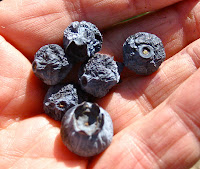I love lox. Who doesn't like lox and bagels for breakfast? Served with a salad and you have a delicious, healthy lunch or light dinner.
Sold in vacuum packed packages, lox is readily available in the refrigerated section of most markets or sold hand-sliced paper thin at specialty deli counters, like New York City's Zabar's or Russ and Daughters.
You can use any part of the salmon, the area close to the tail or the fat mid-section. To ensure even curing, cut the salmon so that the filet is the same thickness through out. If you use the fat mid-section, cut off the thin part of the filet. You can use the thicker part of the mid-section for a sautéed salmon dish and use the thin part to make cured salmon. Or, visa versa
The thicker the filet you use, the longer you will want to leave the salmon to cure. A thin part will cure in a week. The thick part will cure in two-three weeks.
When buying salmon, look for flesh that has a good color. The flesh should be smooth, without fissures.
Your lox is only as good as the ingredients, so use salt that has not been treated with chemicals. I prefer Diamond Cyrstal Kosher Salt.
Home Cured Lox
You can use any part of the salmon, the area close to the tail or the fat mid-section. To ensure even curing, cut the salmon so that the filet is the same thickness through out.
If you use the fat mid-section, cut off the thin part of the filet. You can use the thicker part of the mid-section for a sautéed salmon dish and use the thin part to make cured salmon. Or visa versa.
The thicker the filet you use, the longer you will want to cure the salmon. A thin filet will cure in a week. The thicker part will cure in two-three weeks.
Add flavor with dried aromatics. Dill works very well. If you enjoy a bit of heat, use dried pepper flakes or Korean pepper powder.
Ingredients
1/2 pound fresh salmon, washed and pat dried
1/2 cup Diamond Cyrstal Kosher Salt
1 teaspoon dried aromatic like dill weed
1/4 teaspoon dried pepper powder (optional)
Directions
Use tweezers to remove all the pin bones, those very thin bones that are located in the middle of the filet. Discard.
Many people do not like the darker flesh close to the skin. Using a sharp knife, cut the dark parts of the flesh and the skin. Remove and reserve to thinly slice and deep fry for a delicious treat to serve on steamed rice.
On the kitchen counter, lay a sheet of plastic wrap 5" larger than the filet. Sprinkle the kosher salt onto the plastic wrap. Place the deboned filet on top of the kosher salt. Add the dry aromatic flavoring and (optional) pepper powder on top of the filet. Sprinkle the remaining kosher salt on the filet.
Pull up the edges of the plastic wrap and seal the filet. If needed, use a second sheet of plastic wrap so that the filet is completely sealed in the plastic wrap.
Place the sealed and seasoned filet into an air tight container that is larger than the filet so it can lie flat.
Refrigerate.
Every 24 hours, turn the container over so the filet cures evenly.
You will notice that very quickly the dry seasonings become a slurry as the salt pulls moisture out of the salmon.
Continue turning over the container every 24 hours. One week for thin filets. Two weeks for thicker filets. As you perfect your technique, you may choose to cure the salmon filets longer, depending on your taste.
The filets will not spoil for up to a month.
Serving
Remove the filet from the container and the plastic wrap. Rinse thoroughly in clean, running water. Pat dry. Use a sharp knife and cut the filet into paper thin slices. You don't need to eat all of the filet at one time. Use as much as you want. Rewrap in plastic wrap any unused portions, place into an air tight container and refrigerate for up to a month.
To make a bento-box style treat, cut bread into 2" square pieces, toast and add cream cheese, capers and a slice of your homemade lox. If desired, sprinkle with sea salt and top with a thin slice of tomato.













































